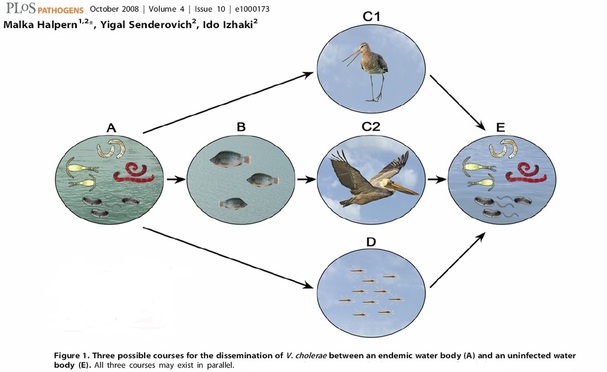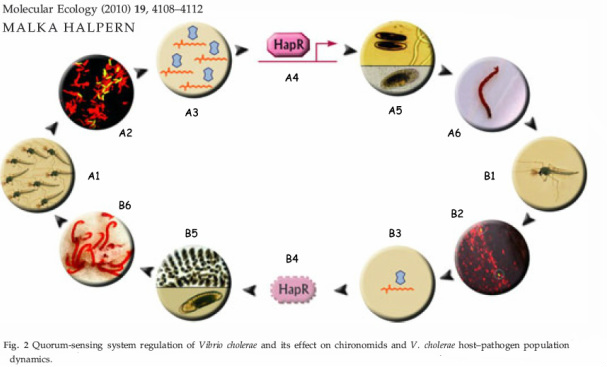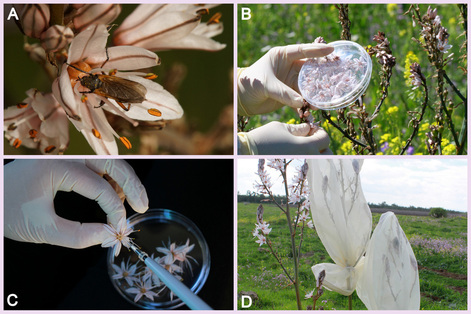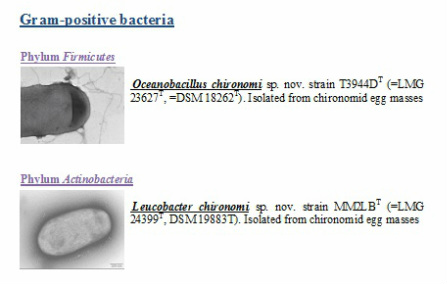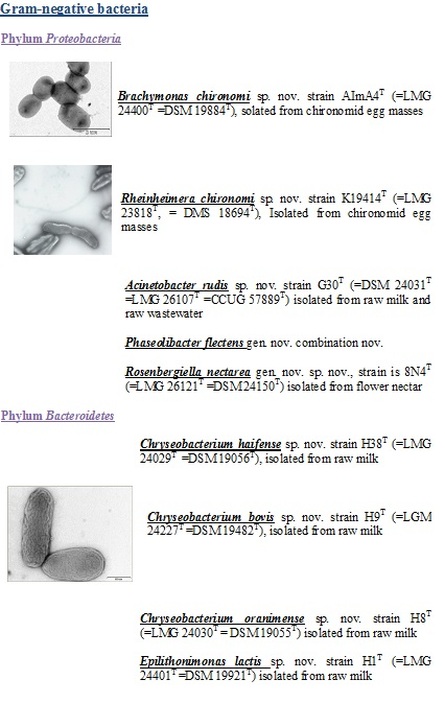Research
1. Chironomids (Diptera; Chironomidae), fish and waterbirds as natural reservoirs and possible vectors of V. cholerae
My main research interest is to understand the ecology of V. cholerae
My main research interest is to understand the ecology of V. cholerae
- We found that chironomids are natural reservoirs of V. cholerae (Broza & Halpern, 2001, Nature).
- We have demonstrated for the first time, that V. cholerae inhabit fish (Senderovich et al., 2010, PLoS ONE)
- V. cholerae may be distributed between continents by waterfowl (Figure 1, Halpern et al., 2008). (In collaboration with Ido Izhaki and Gadi Kazir, Univ. of Haifa, Israel).
- Novel insights into Haemagglutinin Protease (HAP) gene regulation in Vibrio cholerae
- Endogenous bacteria in chironomids
We aim at exploring the role of intrinsic physiological factors of chironomids vs. its endogenous microbiota in maintaining homeostasis under stress conditions. (In collaboration with Bimalendu B. Nath, India; funded by Joint UGC – ISF grant)
2. The ecology and virulence of Legionella spp. populations in freshwater
We use an integrated molecular approach based on high-resolution diagnostics of environmental and clinical isolates to determine the abundance, activity and virulence of Legionella populations' in-situ. (In collaboration with Manfred Höfle, National Research Center for Biotechnology, Braunschweig, Germany and Dina Bahader Bitar, El Quds University, Jerusalem; funded by the DFG).
We use an integrated molecular approach based on high-resolution diagnostics of environmental and clinical isolates to determine the abundance, activity and virulence of Legionella populations' in-situ. (In collaboration with Manfred Höfle, National Research Center for Biotechnology, Braunschweig, Germany and Dina Bahader Bitar, El Quds University, Jerusalem; funded by the DFG).
3. Bacterial community composition of floral nectar and their role in plant fitness
We showed for the first time, that bacterial communities in nectar are abundant and diverse (Fridman et al., 2012, EMR).
Using NGS we are studying bacterial communities of floral nectar and their pollinators (e.g. bees, Aizenberg Gershtein et al., 2013) and visitors, along a spatial climatic gradient across the globe (Figure 3) (In collaboration with Ido Izhaki, Univ. of Haifa, Israel; funded by the ISF).
We showed for the first time, that bacterial communities in nectar are abundant and diverse (Fridman et al., 2012, EMR).
Using NGS we are studying bacterial communities of floral nectar and their pollinators (e.g. bees, Aizenberg Gershtein et al., 2013) and visitors, along a spatial climatic gradient across the globe (Figure 3) (In collaboration with Ido Izhaki, Univ. of Haifa, Israel; funded by the ISF).
4. Taxonomy
In my research, novel bacterial species are being isolated from different environments that were not explored before (e.g. chironomid egg masses, raw milk, floral nectar).
The following list represents novel bacterial species that I, together with my students have isolated, named and characterized:
In my research, novel bacterial species are being isolated from different environments that were not explored before (e.g. chironomid egg masses, raw milk, floral nectar).
The following list represents novel bacterial species that I, together with my students have isolated, named and characterized:
